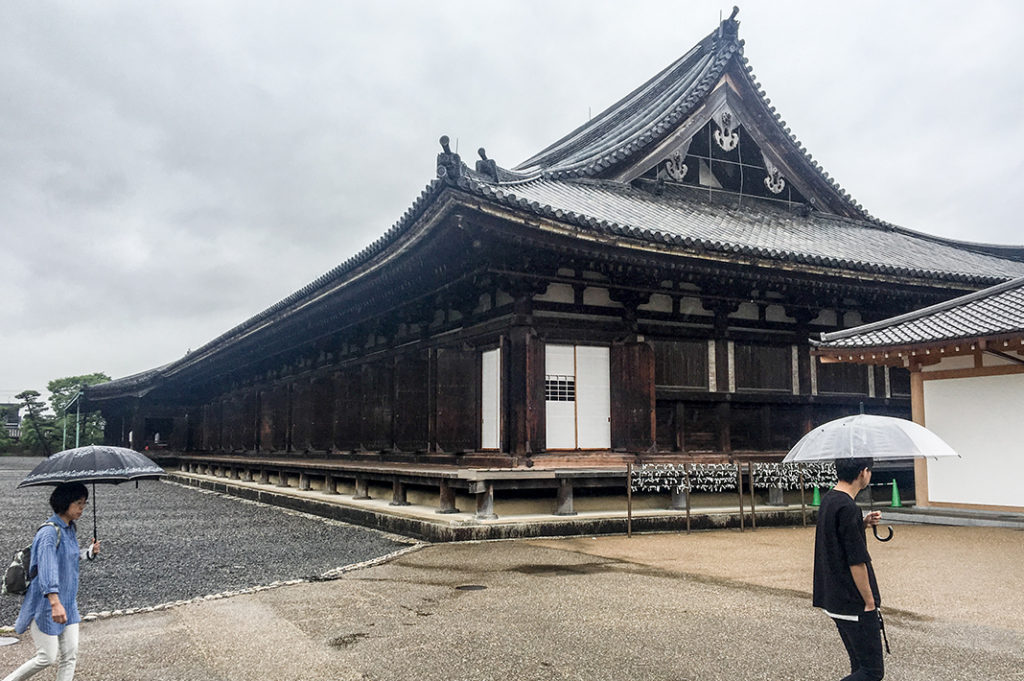Not far from Kyoto’s Fushimi Inari Taisha lies the temple famously home to 1001 statues of Kannon, the Buddhist Goddess of Mercy. Its name—Sanjusangendo— however, refers to an old method of measurement, literally translating to ‘hall with 33 spaces between columns’.

Officially named Rengeoin (Lotus King Temple), all that remains of the complex is the super long main hall. This happens to be Japan’s longest wooden structure at 120 meters, features the best earthquake defence architecture of its time and is a designated National Treasure. In fact, the length of this building once inspired archery competitions to see who could shoot the furthest along its length. Competitions still occur every January.
Surrounding the hall is a wonderfully landscaped garden with many points of interest from the pond to the earthen walls. However, the true attraction lies within the main hall.
Glittering Treasures Await
To enter the wooden building, I first need to remove my shoes and promise not to take any photos. Following the hallway around, I soon arrive in the main hall which stretches far back out of sight. It is quiet save for the creaking floorboards and whispered conversations of those around me. To my left are the white paper screens which face out onto the garden; some are open to let in the fresh breeze and birdsong.
On my right, the main attraction. Ten rows of 100 life-sized kannon statues stand glittering in the otherwise dark hall. Carved out of wood and finished in gold leaf, some of these date back to the temple’s founding in the Heian Period (794 to 1185). Most, however are reconstructions, after fire claimed many in the 1200s. It goes without saying that the ‘no touching’ rule is strictly enforced.
Every so often, a larger guardian deity statue stands in front of the rows of golden Kannon looking ferocious. There are 28 guardians in total which bear names and character descriptions.
Halfway along the hall sits the 3.3m tall statue of a seated 1,000 armed Kannon bodhisattva. This national treasure was carved by the talented sculptor Tankei in 1254. With crystal eyes for a life-like appearance, this is considered one of the best likenesses of Kannon from the Heian Period. The detail of this statue is incredible. Coupled with the sheer volume of statues, the effect is overwhelming. As I take it in all of these national treasures, the pleasant aroma of incense wafts by.
Sanjusangendo Temple Grounds
Once you have walked the length of statues, head around behind them into a long hallway come museum. There you’ll spot pictures, examples of roof tiles, small replica statues as well as vintage bows and arrows from the archery competitions.
The temple grounds also make for a pleasant stroll. Circle the pond, admire the bell. Be dazzled by the vermillion red gates and corridors and the swaying willow trees. Contemplate the earthen walls or the gnarled and bowing pines.
This temple is the last ‘one thousand kannon hall’ (sentai kannon-do) in the world. Full of glittering treasures with a quiet, peaceful atmosphere, it’s one Kyoto attraction not to be missed. While you’re in the area, take the train a few stops and visit Fushimi Inari Taisha, another of Kyoto’s most popular shrines.
Sanjusangendo
Address: 657 Sanjusangendomawari, Higashiyama Ward, Kyoto
Open: 8:00am–5:00pm (7 days)
URL: http://www.sanjusangendo.jp/ (in Japanese)
Post by Japan Journeys.